Source: SDG&E
January 20, 2025 (San Diego) – Due to extreme fire weather conditions and forecasted Santa Ana winds, San Diego Gas & Electric Company (SDG&E) has notified 83,609 customers that it may have to turn off power to reduce wildfire risk as early as late today. Public Safety Power Shutoffs (PSPS) are approved by state regulators as a safety tool of last resort to mitigate fire risk during dangerous weather conditions.
As a result of dry conditions and expected Santa Ana windsup to 60 miles per hour locally, the National Weather Service has issued a Red Flag Warning and High Wind Warning for parts of Orange and San Diego Counties beginning Monday morning through late Tuesday night.
SDG&E has activated its Emergency Operations Center and staffed it with key personnel to monitor weather conditions throughout the duration of the event, especially the wind speeds in the high fire risk areas of the county.
If SDG&E implements a PSPS for public safety, it will open Community Resource Centers to support impacted customers.
Given the potential for extended power outages, SDG&E encourages customers to be prepared. Outage preparedness tips can be found at sdge.com/outage-center; safety guidelines for generator use can be found at sdge.com/generator.
As always, customers should never approach a downed line and should report it by calling 911 or SGD&E’s call center at 800-411-7343. Real-time information about unplanned power outages can be found at sdge.com/outage.
Updates about this PSPS can be found at sdge.com/Ready and SDGEToday.com or by following SDG&E’s X channel, @SDGE.
President Biden also laid out proposed future reforms, including a Constistutional amendment to limit presidential immunity, tax reforms, and term limits for Supreme Court justices
By Miriam Raftery
Hear audio of President Biden’s farewell address; view video, read transcript
January 19, 2025 (Washington D.C.) – In his farewell address to the nation delivered in the White House oval office on January 15, President Joe Biden issued a warning reminiscent of the farewell speech delivered by President Dwight Eisenhower in 1961.
“Today, an oligarchy is taking shape in America of extreme wealth, power and influence that literally threatens our entire democracy, our basic rights and freedoms, and a fair shot for everyone to get ahead,” President Biden said. Specifically, he cited “the concentration of technology, power and wealth” and warned of “dangerous consequences if their abuse of power is left unchecked.”
President-elect Donald Trump, who will be inaugurated tomorrow, has surrounded himself with wealthy tech company executives, drawing controversy. There are parallels to the Russian oligarchs who wield undue influence over Russia’s president Vladimir Putin and have profited from his reign, while supporting his policies. Trump has tapped billionaire Elon Musk, head of Tesla and Space-X which both have received large federal contracts or grants, to lead a non-governmental commission called the Department of Government Efficiency to improve government “efficiency” and recommend deep spending cuts. Critics have said this poses a conflict of interest for Musk.
Other tech billionaires have changed their business platforms to appease Trump after he leveled criticisms. Mark Zuckerberg, head of Meta, halted fact-checking on Facebook. Jeff Bezos, who owns Amazon as well as the Washington Post, blocked an editorial decision to endorse Kamala Harris over Trump and announced an end to diversity, equity and inclusive policies in line with Trump’s stated goal of eliminating DEI protections for minorities and women at the federal level.
Musk, Bezos and Zuckerberg all plan to be at Trump’s inauguration. “When you have the three richest men in the country on the dais,” Sarah Anderson, global economy project director at the Policy Studies nonprofit research group told ABC news, “You cannot overlook how much influence the billionaire has on the government.”
Daniel Kinderman, an associate professor of political science at the University of Delaware, agrees with Biden’s assessment that current income inequality in the U.S. now amounts to “oligarchic conditions.” He called the current situation “a turbocharged technological oligarchy that has control over media and technology” by unelected tech tycoons.
Kinderman, in an ABC news interview, pointed out that the top 1% of Americans own 35% of the nation’s wealth and capital, while the bottom 50% of Americans own just 1.5%. He said the nation is now in uncharted territory due to top tech CEOs having more control over public and political discourse. He voiced concern that such CEOs could “write their own rules that just benefit their own industry.”
Biden voiced concern over corporations controlling the media as well as social media. “Americans are being buried under an avalanche of misinformation and disinformation, enabling the abuse of power. The free press is crumbling. Editors are disappearing. Social media is giving up on fact-checking. The truth is smothered by lies told for power and profit.” He also voiced concern about progress toward addressing the climate crisis on the brink of being undone “for power and profit.”
He likened the rise of wealthy moguls with too much power both to the robber barons in the 1920s and to the military-industrial complex that Eisenhower warned Americans about in 1961.
Eisenhower, a respected former general and Republican, warned of the rise of an immense military establishing and arms industry following World War II and the Korean War. “In the councils of government, we must guard against the acquisition of unwarranted influence, whether sought or unsought, by the military-industrial complex,” he warned in his final speech to the nation as President. “The potential for the disastrous rise of misplaced power exists and will persist,” Eisenhower warned, adding that this could threaten American liberties and the democratic process.
Eisenhower noted that a technology revolution had given rise to the growth of the industrial-military complex, but offered a remedy. “Only an alert and knowledgeable citizenry can compel the proper meshing of the huge industrial and military machinery of defense with our peaceful methods and goals, so that security and liberty may prosper together,” Eisenhower concluded, urging Americans to avoid “fear and hate” that fuels wars and division, and to and to instead support “mutual trust and respect” for “peoples of all faiths, all races, all nations” and “all who yearn for freedom.” He called for efforts to end “poverty, disease and ignorance” in order to foster peace and prosperity.
Biden, a Democrat, quoted Eisenhower and similarly called on the American people, the media, and all branches of government to “confront these powerful forces.”
With Republicans controlling both houses of Congress and the presidency, however, the prospect of the legislative branch serving its role of checks and balances appears dim. Similarly, a Supreme Court with a 6-3 conservative majority, including three justices appointed by Trump in his first administration, has issued a ruling granting near-total immunity to a president for any official acts while in office, dimming hopes of judicial oversight.
That leaves the free press and most significantly, the public. In the 1920s, the abuses of the robber barons eventually diminished in large part due to the rise of labor unions and new legislation to rein in those abuses. Massive protests led to the end of the Vietnam War in the 1970s. Most recently, some Americans have pushed back on tech giants’ actions; 250,000 cancelled their subscriptions to the Washington Post over Bezo’s decisions supporting Trump, while millions have dropped accounts on Facebook, Instagram and X sites owned by the tech-oligarchs.
President Biden laid out a list of specific actions he hopes will someday be taken to protect our democracy and national security. Those include:
- Assure that artificial intelligence development is led by America, not China;
- Reform the tax code to have billionaires pay their fair share, instead of getting massive tax cuts;
- Get dark money contributions out of politics;
- Enact 18-year term limits and ethics requirements for Supreme Court justices
- Ban members of Congress from trading stock while serving in the House or Senate; and
- Amend the Constitution to make clear that no president is immune from crimes he or she commits while in office.
After Biden's farewell address, Google reported a sharp rise in searches for the term "oligarch"; among the top 10 states with rises in searches for the term, eight were in red Republican-controlled states, ABC reports.
Biden’s speech also included confirmation of the cease-fire deal reached with Hamas, which today released several hostages in the first step toward a permanent cease fire.
He also highlighted his administrations accomplishments, including guiding America out of the COVID pandemic, creating nearly 17 million new jobs, getting a major bill passed to rebuild the nation’s infrastructure, passing the most extensive green energy measure ever, strengthening the NATO alliance and helping Ukraine stay free, giving Medicare the power to lower prescription drug costs, getting medical care for veterans exposed to toxins, and launching “a new era of American possibilities.”
He voiced confidence in the ideals that America stands for, the concept that “all of us deserve to be treated with dignity, justice and fairness.” But to protect our rights, freedoms and dreams, Biden said, “We have to stay engaged in the process,” even when that’s frustrating.
He reflected on the Statue of Liberty as an abiding symbol of liberty and the ideal that everyone deserves to be treated with “dignity, justice and fairness.” He told of a veteran known as keeper of the flame, because he was in charge of polishing the statue’s torch to keep the light shining visibly,
“Now it’s your turn to stand guard. May you all be the keeper of the flame,” Biden told the American people.
By Miriam Raftery
January 19, 2025 (San Diego) – January’s freakish weather continues with both fire danger and frost forecast for this week. The weather hazards line up for a potentially “worse case” scenario, the National Weather Service predicts.
A red flag warning has been issued for San Diego County’s inland mountains and valleys Monday and Tuesday due to low humidity and strong winds forecast.
Cold mornings will also bring frost in sheltered inland valleys west of the mountains.
Widespread wind gusts over 35 miles per hour are expected, with a high potential for gusts up to 60 miles per hour in the mountain areas Monday and Tuesday.
Inland valleys and lowlands may also see gusts over 40mph. A second round of Santa Ana winds is expected Thursday.
 There is a chance of patchy fog that may reduce visibility in the early morning, resulting in hazardous conditions for travel.
There is a chance of patchy fog that may reduce visibility in the early morning, resulting in hazardous conditions for travel.
Stay safe! Sign up to receive free East County Wildfire and Emergency Alerts via email at https://www.eastcountymagazine.org/wild-fire-alerts.
You can also follow EastCountyAlert on X (formerly Twitter.)

By Michael Howard
Photo: La Mesa City Councilmember Laura Lothian speaks during a January 14, 2025 City Council meeting. Screenshot from City of La Mesa meeting video.
January 19, 2025 (La Mesa, CA) - La Mesa City Councilmember Laura Lothian is calling for a “15-Strikes And You’re Out” policy to address the rising cost and associated risks of managing the homelessness crisis in the city.
“If you watch the [Homeless Outreach and Mobile Engagement] video on our website, they say, right there, that it takes at least 15 contacts before a person experiencing homelessness is ready to accept services,” Lothian reported during the January 14 City Council meeting. “My feeling is this,” the first-term council member continued. “If the City of La Mesa offers a homeless individual – approaches them – 15 times and offers them help, and 15 times that homeless person rejects that help, I think it’s time for the city to say you need to go,” she insisted.
Lothian’s comments came during the City Council's consent calendar portion of the meeting, when the Council typically votes to approve agenda items in bulk. La Mesa’s Homeless Outreach and Mobile Engagement (HOME) program’s 3rd Quarter report was an item on the calendar, prompting her to speak up.
“Despite increased spending on La Mesa’s Homeless Outreach and Mobile Engagement program, the 2024 count for La Mesa showed a 47% increase in unsheltered homelessness compared to 2023,” Lothian began. “The program is not reducing homelessness in La Mesa and we keep doubling down,” she went on to say. “If the L.A. fires tell us anything, it’s time we stop wishing for results and start getting them with common sense.”
Lothian’s statement comes amid the ongoing, but now slowing spread of fires in the Los Angeles area. Lothian associated fire risk with homelessness in her remarks.
“According to the news I’ve been reading, 54% of the fires that the LA Fire Department responds to are started by the homeless. NBC 7 investigation showed fire incident calls tied to homelessness is sharply on the rise in San Diego,” she cited.
It is true that a rising number of fires in L.A. are caused by homeless people; NBC Los Angeles reported last May that 13,909 fires in 2023 were tied to homelessness, double the prior year. However, according to Cal Fire, the cause of the major wildfires currently burning in L.A. have not yet been determined.
A number of small fires locally have also started at homeless camps. Most recently, according to a recent NBC 7 report, firefighters responded to a fire in El Cajon this past Wednesday that was started by a homeless man trying to stay warm, prompting warnings of a heightened risk of fires due to the cold and dry weather.
“When you have people that are homeless, and they're trying to survive outside, they will do what they need to do to try and stay warm. Sometimes that involves lighting a fire and, as we know, in these conditions, fires like that could potentially spread,” Heartland Fire and Rescue Deputy Chief Todd Nelson said in the news story.
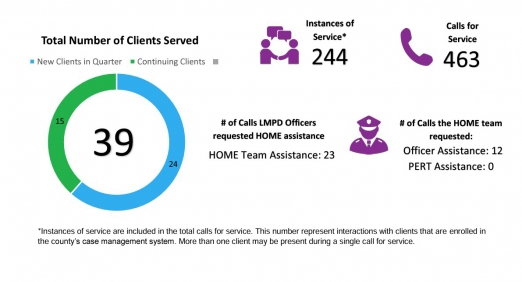 To offset homelessness in La Mesa, the La Mesa City Council in February of 2021 adopted the “2021-2026 Homeless Action Plan” that outlined a proactive approach where the city would take a more “direct role in day-to-day engagement and outreach with the La Mesa homeless population.” The action plan is largely implemented through the HOME program, where the focus is to divert calls that would typically use city emergency and law enforcement services to this program that responds to nonemergency calls for service related to homelessness.
To offset homelessness in La Mesa, the La Mesa City Council in February of 2021 adopted the “2021-2026 Homeless Action Plan” that outlined a proactive approach where the city would take a more “direct role in day-to-day engagement and outreach with the La Mesa homeless population.” The action plan is largely implemented through the HOME program, where the focus is to divert calls that would typically use city emergency and law enforcement services to this program that responds to nonemergency calls for service related to homelessness.
In the Quarter 3 2024 HOME report submitted to the January 14 La Mesa City Council meeting, the program reported a total of 6,246 instances of services to homeless individuals since 2020, 244 of those in Q3 2024. Additionally, the program has housed 177 people in this period, 4 of which were permanently housed in Q3 2024 and 2 temporarily housed in Q3 2024.
Photo: Excerpt from La Mesa's HOME program Q3 2024 report, highlighting clients served in the program's efforts to stem homelessness in the city. Courtesy of the City of La Mesa
La Mesa Police Chief Ray Sweeney also spoke on the issue, responding directly to councilmember Lothian’s suggestion to presumably remove homeless individuals from the city.
Photo: La Mes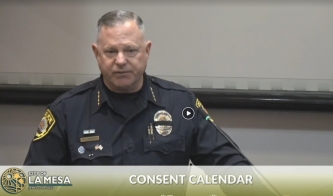 a Chief of Police Ray Sweeney addresses the City Council during its January 14, 2025 meeting; screenshot from City of La Mesa meeting video.
a Chief of Police Ray Sweeney addresses the City Council during its January 14, 2025 meeting; screenshot from City of La Mesa meeting video.
“There’s that balance, Councilmember, we have to make sure we’re not violating their rights, especially if they are not committing crimes – if they’re not doing anything any other member of the public would do in public,” he said. “The balance of different methods and the things in our toolbelt, like you can see I have here, these are all things we’re thinking about, so it’s not just a single approach of progressive engagement.”
Vice-Mayor Patrica Dillard praised the HOME program and Chief Sweeney, noting the complexities of homelessness.
“People have different reasons why they turn down help. A lot of the times we don’t learn what those reasons are, ever,” she disclosed. “I feel the Chief [Sweeney] nailed it on this issue, we’re never going to get all of the homeless off the streets, it’s just not going to happen.”
Dillard finished with a sharp retort. “I believe doing something, and also being able to produce results, is better than nothing, or just complaining,” she said.
Members of the public did not comment on the issue.
In other actions, the Council divided up internal and external committee commitments among themselves for the new year.
SOURCES
Bremer • •, S. (2025, January 15). Dry, windy conditions in San Diego County raise concern over encampment fires. NBC 7 San Diego. https://www.nbcsandiego.com/news/local/san-diego-county-encampment-fire-concerns/3725144/
Cann, C. (n.d.). What caused the LA wildfires? Here’s what we know about the possible origins. USA TODAY. Retrieved January 17, 2025, from https://www.usatoday.com/story/news/nation/2025/01/15/what-caused-los-angeles-wildfires-california/77715865007/
City of La Mesa. (n.d.-a). 2021-2026 HOMELESS ACTION PLAN. https://www.cityoflamesa.us/DocumentCenter/View/17134/Homeless-Action-Plan
City of La Mesa. (n.d.-b). Archive Center • HOME Quarterly Reports. Retrieved January 17, 2025, from https://www.cityoflamesa.us/Archive.aspx?AMID=109&Type=&ADID
City of La Mesa. (n.d.-c). City Council—January 14, 2025. Retrieved January 17, 2025, from https://pub-lamesa.escribemeetings.com/Meeting.aspx?Id=1c6ffa3c-b8f4-4626-bb67-aac9daee9e8d&Agenda=Agenda&lang=English&Item=9&Tab=attachments
City of La Mesa. (n.d.-d). HOME Program | La Mesa, CA - Official Website. Retrieved January 17, 2025, from https://www.cityoflamesa.us/1646/HOME-Program
City of La Mesa. (2024). City of La Mesa Homeless Outreach & Mobile Engagement (HOME) Program Quarterly Report: July – September 2024. https://pub-lamesa.escribemeetings.com/filestream.ashx?DocumentId=17801
Doug Smith, James Queally, & Genaro Molina. (2021, May 12). LAFD: 54% of fire responses in first 3 months of 2021 related to homelessness. FireRescue1. https://www.firerescue1.com/fire-attack/articles/lafd-54-of-fire-responses-in-first-3-months-of-2021-related-to-homelessness-8pgDS8dKNw018Uyv/
Page • •, E. S. (2024, December 2). Homeless arsonist sparked 9 fires in November, including in East County: Cal Fire. NBC 7 San Diego. https://www.nbcsandiego.com/news/local/homeless-arsonist-sparked-9-fires-in-november-including-in-east-county-cal-fire/3689620/
Grover, Joel (2024, May 9. Up in flames: Rising number of homeless fires threaten L.A. neighborhoods. NBC 4 Los Angeles. https://www.nbclosangeles.com/investigations/la-homeless-encampment-fires-electrical-supply-wires/3408775/
Council asks staff to revise resolution, which will be on the agenda January 28
By Miriam Raftery
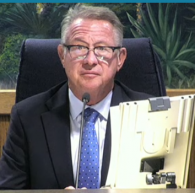 "I see this as disrespectful from you, the Council, the Mayor and the attorneys...This is going to create a lot of distrust in the community.” -- Jose Cruz, photo, left
"I see this as disrespectful from you, the Council, the Mayor and the attorneys...This is going to create a lot of distrust in the community.” -- Jose Cruz, photo, left
"It's about following the law. California is asking us to ignore federal law."--Mayor Bill Wells, photo, right
January 17, 2025 (El Cajon) – In emotional testimony, leaders of the Latino community and others pleaded with El Cajon City Council members on January 14 to reject a resolution proposed by Mayor Bill Wells aimed at maximizing the city’s cooperation with federal immigration authorities. With President-Elect Donald Trump’s announced mass deportation intent, which Trump has said could include all undocumented immigrants in the U.S., many speakers voiced fears over potential discrimination by police against people of color, as well as fears that even long-term immigrants and children who have committed no crimes could be rounded up for deportation.
Trump has also said he wants to deport some special protection status immigrants who came here legally, such as Haitians; others with TPS status include Afghans and Iraqis who helped the U.S. military, Ukrainian refugees, and others.
The controversial proposal split the all-Republican Council. After public outcry from speakers unanimously opposed to the resolution, the city council asked staff to make amendments and bring a revised version back for consideration at the January 28 council meeting, with two members voicing strong concerns.
Specifically, El Cajon’s resolution would declare the city’s intent to “assist federal immigration authorities in their enforcement efforts to the maximum legal extent possible under SB 54, the Supremacy Clause of the U.S. Constitution, and other applicable laws for the purpose of removing those posing a threat to public safety from our community. SB 54 is a California law that bans police from detaining most immigrations or cooperating with immigration authorities unless the immigrant has been convicted of certain serious felony crimes.
City Manager Graham Mitchell said that conflicting federal, state and county laws “put us in a tight spot,” noting that a letter sent by El Cajon to the state attorney general has thus far not been answered.
El Cajon is alone among local cities seeking to adopt such a resolution.
ECM asked neighboring La Mesa’s Police Chief Ray Sweeney how his police force is handling the issue. “We’re following state law. Simple--that’s it,” he said.
San Diego County Sheriff Kelly Martinez similarly has said she will follow state law, not potentially more stringent federal requests, nor County Supervisors’ more liberal resolution seeking to protect more immigrants than under state law. The Sheriff’s department provides protection for all other East County communities, including the cities of Santee and Lemon Grove, as well as all unincorporated areas.
Public comments
Some community members spoke during public comments, while others waited until the agendized item.
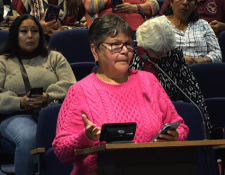 Some speakers voiced fear, others expressed outrage, and one threatened legal action.
Some speakers voiced fear, others expressed outrage, and one threatened legal action.
Eva Pacheco (photo, left) said she has lived in El Cajon for 34 years. Though the resolution claims its aim is to protect public safety, Pacheco said if police collaborate with immigration officers, “The safety of our community is not in play because they will fear the police...especially at the school I am working with, they will be less likely to seek help or report (crimes) to police officers. We have seen this...before, and with this resolution it will be worse. I really, really want toknow as a government body that you are here for the entire community....Talk to the families,” she concluded, drawing applause from the audience.
 Dr. Sergio Conti (photo, right), who is originally from Argentina, said his family moved to El Cajon last February and is enjoying “this beautiful city,” but is concerned that could change if the resolution passes. “Of the population in El Cajon, 28% speaks Spanish,” he said, noting that mass deportation could eliminate farmworkers and perhaps city workers who are Spanish-speaking. He emphasized that the vast majority of immigrants are not criminals.”We came here for one reason: to give a better future to our son,” he said, adding that his son is studying at the University of California, San Diego to be a history professor. “We work hard every day to make money to pay the rent and feed our families.” He said he opposes the resolution “because it will destroy the lives of many families who only want to work in peace and give a future to their children.”
Dr. Sergio Conti (photo, right), who is originally from Argentina, said his family moved to El Cajon last February and is enjoying “this beautiful city,” but is concerned that could change if the resolution passes. “Of the population in El Cajon, 28% speaks Spanish,” he said, noting that mass deportation could eliminate farmworkers and perhaps city workers who are Spanish-speaking. He emphasized that the vast majority of immigrants are not criminals.”We came here for one reason: to give a better future to our son,” he said, adding that his son is studying at the University of California, San Diego to be a history professor. “We work hard every day to make money to pay the rent and feed our families.” He said he opposes the resolution “because it will destroy the lives of many families who only want to work in peace and give a future to their children.”
 Jesus Pacheco (photo, left) from Latinos en Accion voiced concern that the resolution would damage the relationship between immigrants and police. “You represent all of us. All of us pay taxes, and we try to the best we can,” said Pacheco, who said he’s lived here for 34 years and has long been a volunteer advocate for quality education, recently succeeding in opening a new building for a middle school locally. “Think about us, and make the right decision,” he urged the Council.
Jesus Pacheco (photo, left) from Latinos en Accion voiced concern that the resolution would damage the relationship between immigrants and police. “You represent all of us. All of us pay taxes, and we try to the best we can,” said Pacheco, who said he’s lived here for 34 years and has long been a volunteer advocate for quality education, recently succeeding in opening a new building for a middle school locally. “Think about us, and make the right decision,” he urged the Council.
Jose Cruz said he is a U.S. citizen who went to El Cajon High School. “We got stopped by police. They sent Border Patrol who kept us there for hours, just harassing us,” he shared. “I don’t want to deal with that. I don’t want my kids to go through that...If your police do that, they should ask for a passport for every single citizen of El Cajon...I’m very upset with you,” he said, voicing fears that those with brown skin could be subject to stops and detention. “I’m a peaceful person...but I see this as disrespectful from you, the Council, the Mayor and the attorneys...This is going to create a lot of distrust in the community.” He said victims of crimes such as domestic violence won’t report those crimes if they fear police will call immigration officers. “I am a U.S. citizen. They won’t report me...but I don’t want an immigration officer to ask me for papers.”
 He told Mayor Wells, “I voted for you, Mr. Mayor, but this just breaks my heart, to be honest with you...I have a 7-year-old boy. I don’t want him to grow up in a place that feels like a police state for brown people. If this thing passes, I might sell my house and move,” he closed, drawing applause.
He told Mayor Wells, “I voted for you, Mr. Mayor, but this just breaks my heart, to be honest with you...I have a 7-year-old boy. I don’t want him to grow up in a place that feels like a police state for brown people. If this thing passes, I might sell my house and move,” he closed, drawing applause.
Mayor Wells interjected, “This is not about taking our police force and turning them into immigration authorities...It’s about following the law. California is asking us to ignore federal law.”
Cruz fired back,”As a Republican, we talk about local issues. This is a local issue.”
The Mayor insisted, “It’s not for us to decide.”
Cruz responded, “It is, and deciding to vote you out next time!” He added that he was talking from personal experience and recalled that as a 14 year old, he was asked for papers. In addition, he said if the resolution passes, besides creating conflicts in the immigrant community, “you’ll be diverting funds from trying to take care of homelessness to rounding up people.”
 Violet Lombera (photo,right) with Latinos en Accion said after moving to El Cajon from Brawley, she was stopped by police in what she views as “racial profiling. I don’t want that to happen again...Doing this is really going to separate and divide us. It’s going to attack my community, Mexican Americans...I’ve been attacked. I’ve been segregated. I’ve been racially profiled. You guys need to reconsider this,” she said, voicing fears of people being stopped and asked for proof of citizenship. ”To do this is really going to hurt everybody in our community.”
Violet Lombera (photo,right) with Latinos en Accion said after moving to El Cajon from Brawley, she was stopped by police in what she views as “racial profiling. I don’t want that to happen again...Doing this is really going to separate and divide us. It’s going to attack my community, Mexican Americans...I’ve been attacked. I’ve been segregated. I’ve been racially profiled. You guys need to reconsider this,” she said, voicing fears of people being stopped and asked for proof of citizenship. ”To do this is really going to hurt everybody in our community.”
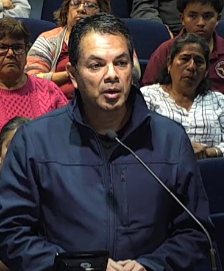 Pedro Rio (photo, left) is director of the American Friends Service Committee’s border program. “I’ve been working with community members in El Cajon for two decades or more. Considering passing this resolution is showing your true colors,” he said, then accused the Mayor of “fearmongering” that would make people afraid to walk around or shop in the city. He criticized the city manager’s statement that state law prohibits cities from using Border Patrol agents to translate, noting that such use over the years has been a pretext that led to deportation, family separations and “suffering.”
Pedro Rio (photo, left) is director of the American Friends Service Committee’s border program. “I’ve been working with community members in El Cajon for two decades or more. Considering passing this resolution is showing your true colors,” he said, then accused the Mayor of “fearmongering” that would make people afraid to walk around or shop in the city. He criticized the city manager’s statement that state law prohibits cities from using Border Patrol agents to translate, noting that such use over the years has been a pretext that led to deportation, family separations and “suffering.”
He cited Mayor Wells’ past quote claiming nearly 20 million people crossed the U.S. border illegally. “You’re misinformed,” Rio said. “Most are seeking asylum, a legal right. I implore you to read and understand the laws of this country before engaging in fearmongering and creating so much trauma in the community, for your constituents...We need to wake up and take care of this or we will lose this country completely, and a lot of us are going to lose our lives.”
Salvador Salmiento with the National Day Labor Network said he believes the Council may have good intentions, but added, “The road to hell is paved with good intentions. Our organization has litigated a bunch of these policies over the years,” adding that he has over the years repeatedly seen ICE (Immigrations and Customs Enforcement) detainers issued without probable cause.
Then he warned that if this happens in El Cajon, ”We will sue, as we have” when this occurred elsewhere, adding that in such lawsuits, “ICE doesn’t pay. The city pays...This is a public cost. I know you care about El Cajon. Don’t make this the only thing people hear about El Cajon for the next four years...If this is symbolic, it will still be damaging. If there is actual damage....we will sue...El Cajon, you are all so much better than this. Say no today. El Cajon can be a better example than this.”
Adriano Jasso with the American Friends Service Committee supported members in El Cajon and held meetings with the former Chief of Police regarding SB 54 implementation. “We highlighted the importance to have trust,” Jasso said. “Declaring the intention to assist with federal authorities will set you aside from the rest of the County and potentially bring a spotlight to the community that is anti-immigration, anti-worker, anti-family,” adding that this would “add to the anxiety and uncertainty for people who may be in the country without documentation. Think about the mixed status families; what message are you sending to school children?” She urged Council to reject the resolution and remember that the represent all the people of El Cajon, including families, children and workers.
Arlette Reyes, a nurse and American citizen who came here as an immigrant, said her parents brought her here because Mexico in those days didn’t have enough opportunities for women. “The 1960s and ‘70s are really not that far away,” she said, recalling an era when Spanish could not be spoken in schools, segregation of Mexican-Americans occurred, and police engaged in racial profiling. She fears that people with foreign-sounding names and dark skin will “not be looked at like a citizen.” Reyes
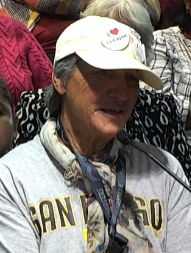 voiced fear for her daughter, who is African-American and Mexican-American, adding that she wants the city to focus on the homeless. Instead of targeting migrants, noting that most of the homeless are “citizens, born and raised here.”
voiced fear for her daughter, who is African-American and Mexican-American, adding that she wants the city to focus on the homeless. Instead of targeting migrants, noting that most of the homeless are “citizens, born and raised here.”
Brenda Hammond (photo, right) invited everyone to “look up the Lemon Grove incident,” which was a segregation case involving the Lemon Grove School District and Mexican-American children. She said most of her friends are Mexican-Americans who came here as children or young people to escape serious problems. “They are grandparents now.”
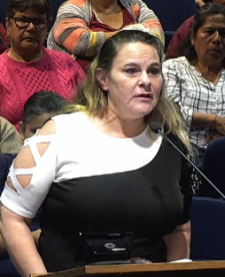 Stephanie Harper (photo, left) observed, “The last time I heard anybody talk about `let me see your papers’ was Nazi Germany. That’s really scary. A lot of people here are scared, too...We’re all immigrants, unless you’re Indian.” She quoted former president Ronald Reagan: “You can come to American and become an American. That’s what makes us great.” She said the resolution will cause “problems we can’t foresee,” then told the Mayor, “I think this is just a step in your political career, Mr. Wells, to show other people what you’ve done,” adding that this action would not be a good one. The crowd applauded.
Stephanie Harper (photo, left) observed, “The last time I heard anybody talk about `let me see your papers’ was Nazi Germany. That’s really scary. A lot of people here are scared, too...We’re all immigrants, unless you’re Indian.” She quoted former president Ronald Reagan: “You can come to American and become an American. That’s what makes us great.” She said the resolution will cause “problems we can’t foresee,” then told the Mayor, “I think this is just a step in your political career, Mr. Wells, to show other people what you’ve done,” adding that this action would not be a good one. The crowd applauded.
Council discussion
 Councilwoman Michelle Metschel (photo, right) said she’s talked to residents including in the Hispanic community and believes “they have a real fear that their community is targeted.” She voiced concern that her daughter, whose father is from El Salvador, could be targeted and noted that one relative “may be illegal.” She noted that our region has immigrants from around the world and wants to be sure if “bad actors” are the issue that Hispanics are not targeted.
Councilwoman Michelle Metschel (photo, right) said she’s talked to residents including in the Hispanic community and believes “they have a real fear that their community is targeted.” She voiced concern that her daughter, whose father is from El Salvador, could be targeted and noted that one relative “may be illegal.” She noted that our region has immigrants from around the world and wants to be sure if “bad actors” are the issue that Hispanics are not targeted.
“I originally signed on to support this,” she said of the resolution, “but as an adult and a representative of my community, I’m entitled to chance my mind as I get more information and as people talk to me,” Metschel added, drawing applause. “These are the heart and soul of what we’re representing,” she said of the speakers present. “I am elected to support them.”
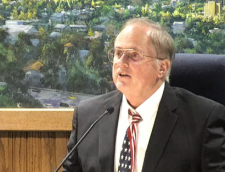 Vice Mayor Gary Kendrick (photo,left) gave an impassioned speech, noting that Metschel and public speakers raised some “good points.” Then he revealed, “My mother was living in Czechoslovakia in 1939 when Hitler came in. They said `Jews have to wear yellow stars, but that’s all that we’re doing.’ Then the Gestapo came for her boss, they dragged him out of the office to wash cars, then they dragged him out again and nobody ever saw him again...I’m very concerned about civil rights, because things tend to creep along and get worse...It’s important we work hard to safeguard everybody’s rights,” he resolved, as the crowd applauded.
Vice Mayor Gary Kendrick (photo,left) gave an impassioned speech, noting that Metschel and public speakers raised some “good points.” Then he revealed, “My mother was living in Czechoslovakia in 1939 when Hitler came in. They said `Jews have to wear yellow stars, but that’s all that we’re doing.’ Then the Gestapo came for her boss, they dragged him out of the office to wash cars, then they dragged him out again and nobody ever saw him again...I’m very concerned about civil rights, because things tend to creep along and get worse...It’s important we work hard to safeguard everybody’s rights,” he resolved, as the crowd applauded.
Vice Mayor Kendrick continued, “Immigrants are part of the fabric of our community and I don’t want to tear that apart.” He indicated he was okay with handing over convicted criminals, but added, “I do not want to see children dragged out of church, or out of school.” He agreed that undocumented people would be frightened to report crimes or serve as witnesses, adding, “Criminals know they can get away with horrible things because everybody is afraid they’ll be deported...That’s bad policy.” He noted that immigrants contribute financially and some even pay into Social Security. With the U.S. birth rate below the replacement rate,we need more people to come in, he said. “I believe the vast majority of those are honest, hard-working people who make this a better place,” adding that he thrives on the diversity in El Cajon, such as the manyethnic restaurants.
Then for the first time in his 22 years on the City Council, Kendrick quoted a Bible version from Deuteronomy: “You shall also love the strangers, for you are strangers in the land of Egypt.” Kendrick concluded that he doesn’t want to be on the side of those who rounded up Jews and persecuted others under Hitler, when his mother was young.
Kendrick suggested the resolution, if adopted at all, should be amended to add a sentence limiting its enforcement to “only those convicted of serious crimes,” as state law already allows. “I don’t want people living here in fear, because my mom went through that,” he concluded.
 Councilman Phil Ortiz (photo, right), who represents a heavily Latino district and is from a second-generation Latino immigrant family, thanked the audience for staying civil. “I don’t think there is a city in the county more welcoming to immigrants than El Cajon,” he began, noting that the city translates materials into several languages and offers grants within immigrant communities. But he said the conflict between state and federal immigration laws need to be worked out. “We need clarification as a city; are our police officers going to be prosecuted when we talk to Border Patrol agents or ICE about someone defrauding someone or a domestic violence suspect or someone getting ready to commit a crime?” He said police officers are “just as worried” as immigrants and suggests SB 54 could mean officers being locked up if they cooperate with ICE beyond what the state law allows.
Councilman Phil Ortiz (photo, right), who represents a heavily Latino district and is from a second-generation Latino immigrant family, thanked the audience for staying civil. “I don’t think there is a city in the county more welcoming to immigrants than El Cajon,” he began, noting that the city translates materials into several languages and offers grants within immigrant communities. But he said the conflict between state and federal immigration laws need to be worked out. “We need clarification as a city; are our police officers going to be prosecuted when we talk to Border Patrol agents or ICE about someone defrauding someone or a domestic violence suspect or someone getting ready to commit a crime?” He said police officers are “just as worried” as immigrants and suggests SB 54 could mean officers being locked up if they cooperate with ICE beyond what the state law allows.
He tried to reassure those present that broad roundups of immigrants wouldn’t happen. “People say we’ll become the Gestapo. We don’t have the budget for that,” he said, but insisted, “It doesn’t do the community any good to shelter criminals who shouldn’t even be here.”
 Councilman Steve Goble (photo, left) said he agrees that California and America have thrived because of immigrants, and that trust between immigrants and officials is important. But he insisted that being asked for papers by police won’t happen because it’s prohibited by state law
Councilman Steve Goble (photo, left) said he agrees that California and America have thrived because of immigrants, and that trust between immigrants and officials is important. But he insisted that being asked for papers by police won’t happen because it’s prohibited by state law
“Our interest is protecting you,” he said. Goble suggested changing the title of the resolution, which currently is “Declaring the city’s intent to assist federal immigration authorities to the maximum legal extent permissible under SB 54 and other applicable laws,” to instead emphasize focus on protecting the community. But he maintained that people such as convicted murderers and rapists need to be removed, and that missing unaccompanied minor immigrants need to be found. “We don’t need to find someone who is a landscape company owner or a housekeeper or an accountant or an engineer.”
Councilman Kendrick, seeing that the majority appeared to favor the resolution, suggested sending it back to staff to clarify that police should cooperate with ICE only for convicted criminals.
Goble disagreed. “We are at a precarious situation right now. Two government agencies higher than we are taking opposite sides so we are asking for clarification,”he said, though a resolution isn’t required for the city to continue to seek clarification on legalities. “I don’t think we are being racist or provocative. ...I don’t think we need to send this back,” indicating a willingness to vote for the measure. ”No Nazi Germany situation is happening here,” he added, drawing protests from the crowd. “We don’t want to be prosecuted...this came up because our police officers could lose their jobs, lose pensions, or be sued civilly if they follow the law.
Motions and vote
Goble then made a motion to adopt the resolution.
But Metschel asked pointedly, “Why do we have to make a resolution?”
Mayor Wells conceded, “We don’t have to,” and the audience applauded.
Metschel noted that the city has already asked for guidance from the state attorney general, who didn’t respond. “We already did that. We don’t need a resolution to do that. We don’t need a resolution to maintain public trust...and the majority of the public here right now, they are not trusting us...We’ve affirmed commitment to public safety, so why do we need a resolution to reaffirm commitment to safety?”
The Mayor said, “The reason is because the state of California is at odds with the feds,” though no other local city has seen a need to pass a resolution on this issue.
Goble then proposed a substitute motion to send the draft resolution back to staff to “reflect some of the concerns we’ve heard here today, affirming existing community values and emphasizing the purpose of protecting all citizens from those who have committed crimes and who are here illegally.”
The motion to send the resolution back to staff passed 4 to 1, with only Mayor Wells voting in opposition.
The Mayor thanked everyone for “participating in democracy.”
Next hearing
The revised resolution is slated to be on the agenda for the next El Cajon City Council meeting on Tuesday, January 28 at 3 p.m. at El Cajon City Council Chambers,200 Civic Center Way in downtown El Cajon.
View video of full Council meeting on Jan. 14, 2025
Contact information for El Cajon City Councilmembers:
Mayor Bill Wells
(619) 441-1788 / bwells@elcajon.gov
Gary Kendrick, District 1, Mayor Pro Tem
(619) 441-1788 / gkendrick@elcajon.gov
Michelle Metschel, District 2
(619) 441-1788 / mmetschel@elcajon.gov
Steve Goble, District 3
(619) 441-1788 / sgoble@elcajon.gov
Phil Ortiz, District 4
(619) 441-1788 / portiz@elcajon.gov
East County News Service
January 17, 2025 (La Mesa) — Bougie’s Cheese Shop, newly opened in December, invites you to a Garden Party on Saturday, January 18 and 25 from 1-4 p.m. This patio event will feature non-alcoholic specialty drinks in honor of dry January paired with cheeses, along with curated snack boxes available for purchase.
Bougie’s Cheese Shop is located in the historic Levy house at 4679 Date Ave. in La Mesa.
Source: TSA
January 16, 2025 (Washington D.C.) — During 2024, the Transportation Security Administration (TSA) intercepted a total of 6,678 firearms at airport security checkpoints, preventing them from getting into the secure areas of the airport and onboard aircraft. Approximately 94% of these firearms were loaded. This total is a minor decrease from the 6,737 firearms stopped in 2023. Throughout 2024, TSA managed its “Prepare, Pack, Declare” public awareness campaign to explain the steps for safely traveling with a firearm.
"One firearm at a checkpoint is too many,” said TSA Administrator David Pekoske. “Firearms present a safety risk for our employees and everyone else at the checkpoint. It’s also costly and slows down operations. If individuals who carry a firearm intend to travel, we remind them that the firearm must be unloaded, locked in a hard-sided case, declared to the airline at the check-in counter and transported in checked baggage.”
In 2024, TSA screened more than 904 million people, meaning the agency intercepted 7.4 firearms per million people, a decrease from 7.8 firearms per million people in 2023.
| Total passengers screened | Total number of firearms | Average number of firearms per day | Percentage loaded | Rate per million passengers |
2024 | 904 million | 6,678 | 18.2 | 94% | 7.4 |
2023 | 858 million | 6,737 | 18.4 | 93% | 7.8 |
When a firearm is detected at a security checkpoint, a TSO immediately contacts local law enforcement, who will remove the individual and the firearm from the checkpoint area. Depending on local laws, the law enforcement officer may arrest or cite the individual. TSA does not confiscate firearms. In addition to any action taken by law enforcement, individuals who bring a firearm to a TSA checkpoint face a maximum civil penalty of $14,950, will have their TSA PreCheck® eligibility revoked for at least five years and will undergo enhanced screening to ensure there are no other threats present, which takes up additional time.
For more information on how to properly travel with a firearm, visit the transporting firearms and ammunition page on TSA.gov. View the complete list of penalties on TSA.gov.
For the 2024 Firearms infographic, please click on the link below.
By Brooke Binkowski, Times of San Diego, a member of the San Diego Online News Association
Photo: County Supervisor Jim Desmond delivering his State of North County speech in June. (File photo courtesy of Desmond’s office)
January 16, 2025 (San Diego) - San Diego County Supervisor Jim Desmond announced that he will run for Congress.
By Miram Raftery
January 15, 2025 (San Diego) – President-elect Donald Trump has pledged “mass deportations” of 11 million undocumented immigrants, most of whom do not have criminal backgrounds. But many people are unaware that he has also threatened to revoke temporary protected status (TPS) from some immigrants who are here legally.
San Diego’s East County is home to many people who came here with TPS status, including Iraqis and Afghans who worked for the U.S. government, such as translators for our military, as well as Somalis and Sudanese displaced by civil unrest, and Ukrainians displaced by the Russian invasion.
Currently, 17 nations have TPS designations which protect immigrants such as Afghans who helped the U.S. military, Ukrainians, Syrians and Sudanese with war-torn homelands, and Haitians displaced by earthquakes and gang violence after the assassination of the nation’s president. The list also includes immigrants from Burma, Cameroon, El Salvador, Ethiopia, Honduras, Lebanon, Nepal, Nicaragua, Somalia, Venezuela, and Yemen.
Asked if he would revoke temporary protected status for TPS holders such as Haitians in Springfield, Ohio, Trump told News Nation,” Absolutely, I’d revoke it.”
Vice President-elect J.D. Vance has characterized TPS holders as “illegal aliens” adding, “We’re going to stop doing mass grants of Temporary Protected Status,” the New York Times reports.
Trump and Vance falsely claimed Haitians in Springfield were eating cats and dogs. They have refused to recant those claims, even though Springfield’s Police Chief said there have been no complaints of Haitians eating pets.
Revoking or failing to extend Temporary Protected Status could lead to deportation of many immigrants back to countries that are dangerous due to war or natural disasters.
During Trump’s first administration, he tried to scrap the TPS program for immigrants in the U.S. from a half dozen nations with predominantly black, Hispanic, or Asian residents. The American Civil Liberties Union sued and got a temporary injunction; that case was pending before the U.S. Supreme Court when Joe Biden took office and opted to keep the TPS program, so the case was never heard. With a new conservative majority, including three justices appointed by Trump, however, a similar suit might well be decided in favor of axing TPS status for some or all recipients.
Trump also alienated many in the Iraqi Chaldean Christian Community in 2017, when his Department of Homeland Security identified some 1600 Iraqi nationals for removal, of whom 800 had committed no crimes. Others were decades-old, the Guardian newspaper in London reported.
Of those with criminal records, some had committed only minor offenses, such as a youth convicted of marijuana possession whose record was expunged when he became an adult, yet he was still among 300 Iraqis detained and threatened with deportation despite being a Catholic with cross tattoos, which could put him at risk of torture or death in a Muslim-ruled nation at a time when ISIS terrorists were murdering religious minorities.
One Iraqi man who did have a serious criminal history, also suffering from schizophrenia, died after he was deported to Iraq, after reportedly being beaten and denied insulin to treat his diabetes. Like many Iraqis in the U.S., he spoke no Arabic and had spent most of his life in America. The deportations of Iraqis were ongoing despite a “do not travel” advisory for Americans seeking to visit Iraq due to the dangers there including terrorism and armed conflict.
Mass deportations of TPS recipients here legally, as well as undocumented immigrants, could rip families apart since children born here could remain, while one or both parents could be deported.
Trump has also threatened to deport people sympathetic to Hamas, ostensibly to make college campuses safe. Could this mean deporting Palestinian immigrants and other students protesting the Gaza war?
He has previously shown animosity towards Muslims, notably with his ban on Muslim immigrants during COVID, which courts struck down as unconstitutional.
The question of who might be deported under the next Trump presidency is particularly relevant in communities such as El Cajon, where political leaders are wrestling with whether or not to publicly affirm an intent to cooperate with federal immigration authorities. At yesterday's meeting, after numerous Latino leaders voiced concerns, the Council asked staff to revise the ordinnance; it is expected to be consder at the next El Cajon Council meeting on January 28.
While some believe such a resolution would only support deportation of people who committed crimes, what if the Trump administration defines “crime” to include merely crossing the border illegally decades ago and seeks to deport all undocumented people, even “dreamers” brought here as children? What if efforts go even further, with federal authorities asking local police to round up people whose TPS status is revoked, such as translators who helped our military and would face death if returned home? Or people who fled violence and genocide in some African nations?
Another issue for taxpayers is the cost of mass deportations. The American Immigration Council has estimated that to deport all undocumented immigrants in the U.S. would cost nearly a trillion dollars.
USA Today reports that Trump could use emergency and executive powers to bypass existing protections for immigrants. He could activate powers from decades-old provisions once used to detain Japanese, German and Italians in the U.S. during World War II. He could deploy the military and National Guard members to round up immigrants, push local police forces to cooperate in those efforts, and shift financial resources from other agencies to fund mass deportations.
A key obstacle to Trump’s mass deportation goals is that most nations have said they will refuse to accept immigrants. If no other nation will take them, that could mean immigrants rounded up could languish for years in detention camps. Based on conditions in detention camps during Trump’s first term of office, some immigrants’ lives could be at risk from diseases, stress, or other health-related concerns.
Currently, Congress provides funding for Immigration and Customs Enforcement to detain 41,500 people daily. But the American Immigration Council estimates that deporting even 1 million people a year, as Vance has proposed, would require increasing that 24-fold—a highly costly proposition. If Congress balks at such steep funding, what would then happen to detained immigrants?
Meanwhile, immigrant communities across the U.S. are permeated with fear over the potential to be stopped at any time over the next four years, ripped from their homes, jobs and families, and potentially deported to a homeland they fled due to dangers that still remain.
Sources:
https://www.nytimes.com/2024/11/15/us/trump-immigrants-temporary-protected-status.html
https://www.americanimmigrationcouncil.org/research/temporary-protected-status-overview
https://www.theguardian.com/us-news/2019/jul/17/iraqi-christians-face-deportation-conned-trump
https://www.uscis.gov/policy-manual/volume-7-part-f-chapter-10
https://www.uscis.gov/humanitarian/temporary-protected-status
https://www.politico.com/story/2019/08/07/iraqi-man-dies-deportation-trump-administration-1643512
By Miriam Raftery
Photo, left: Gaza bombing by Israel, WAFA for news agency APA, creative commons via WIkiPalestine
January 15, 2025 (Washington D.C.) – President Joe Biden today announced, “After many months of intensive diplomacy by the United States, along with Egypt and Qatar, Israel and Hamas have reached a ceasefire and hostage deal.”
The deal is slated to halt fighting in Gaza, surge humanitarian aide to Palestinian civilians, and return hostages taken by Hamas during its October 7, 2023 attack in Israel, in exchange for the release of Palestinian prisoners.
Biden indicated the cease-fire is based on a plan he laid out May 31,which the United Nations Security Council endorsed. The action comes after a cease-fire in Lebanon with Hezbollah and weakening of Iran, both allies of Hamas.
 The Hamas attack killed over 1,200 Israelis. Israel’s military retaliation in Gaza has killed tens of thousands, displacing up to 90% of Gaza’s population of 2.3 million, according to the Associated Press. Many of those are injured, have lost homes, or at risk of famine.
The Hamas attack killed over 1,200 Israelis. Israel’s military retaliation in Gaza has killed tens of thousands, displacing up to 90% of Gaza’s population of 2.3 million, according to the Associated Press. Many of those are injured, have lost homes, or at risk of famine.
Photo, right: Hamas attack at Jewish kibbutz in Israel, via Israeli press office
“It is long past time for the fighting to end and the work of building peace and security to begin,” said Biden, who voiced empathy for Israeli families who lost loved ones in the Hamas attack as well as for the “many innocent people killed in the war that followed.”
An estimated 100 hostages remain in Gaza, though the Israeli military believes at least a third are dead, according to the Associated Press. Seven American families have members taken hostage by Hamas, of whom three are believed to still be alive.
The cease-fire calls for a phased plan starting with release of 33 women, children, wounded civilians and older adults in exchange for hundreds of Palestinian women and children prisoners. Soldiers and other male captives will be released in the second-phase.
The deal comes after U.S. President-Elect Donald Trump stated on social media last month that there would be “hell to pay” if hostages were not released by his inauguration on January 20. “It will not be good for Hamas and it will not be good, frankly, for anyone,” he later told reporters.
News of the cease fire prompted mixed reactions.
The Jewish Democratic Council of America stated that its members are “relieved and hopeful that the hostages will soon be reunited with their loved ones” and thanked President Biden and his team. The group urged the incoming Trump administration to “follow through on the measurable progress made by President Biden to end the war in Gaza and ensure that all parties honor their commitments.”
Crowds gathered in Gaza to celebrate news of the cease fire deal, CBS reports. "I am very happy, and today is the day I wished to hear about since the beginning of the war. God is sending us hope,” an elderly man told CBS.
Hamas leader al-Hayya, however, hinted at revenge, Al-Jazeera reports. “We say, in the name of the orphans and the children and the widows, in the name of people with destroyed homes, in the name of the families of the martyrs and the wounded, in the name of all the victims, in the name of every drop of blood that was spilled, and in the name of every tear of pain and agony: We won’t forget, and we won’t forgive,” al-Hayya said.
The World Jewish Conference took a longer term view, “This is not just Israel’s battle; it is a fight for the values of humanity itself,” the group stated, San Diego Jewish World reports. “The international community must keep up the pressure on Hamas and refuse to again allow terror to reign over the Gaza Strip. Only when terrorism is eradicated and the rule of law and decency restored can Israelis and Palestinians begin to live side by side in lasting peace and security. “Today, we are grateful to those who brought about this agreement, and we insist that it by fully implemented. But we also redouble our commitment to a secure future for Israel and the region. The road ahead is steep, but we are steadfast in our belief that even in darkness, light can prevail.”
United Nations Secretary-General Antonio Guterres welcomes the ceasefire announcement, adding, “The priority now must be to ease the tremendous suffering caused by this conflict. The United Nations stands ready to support the implementation of this deal and scale up the delivery of sustained humanitarian relief to the countless Palestinians who continue to suffer,” he said at a news conference.